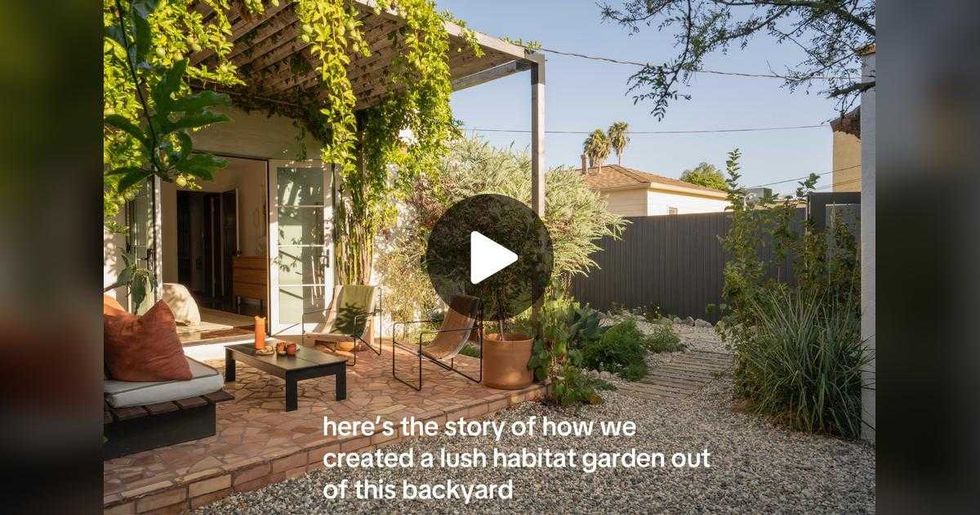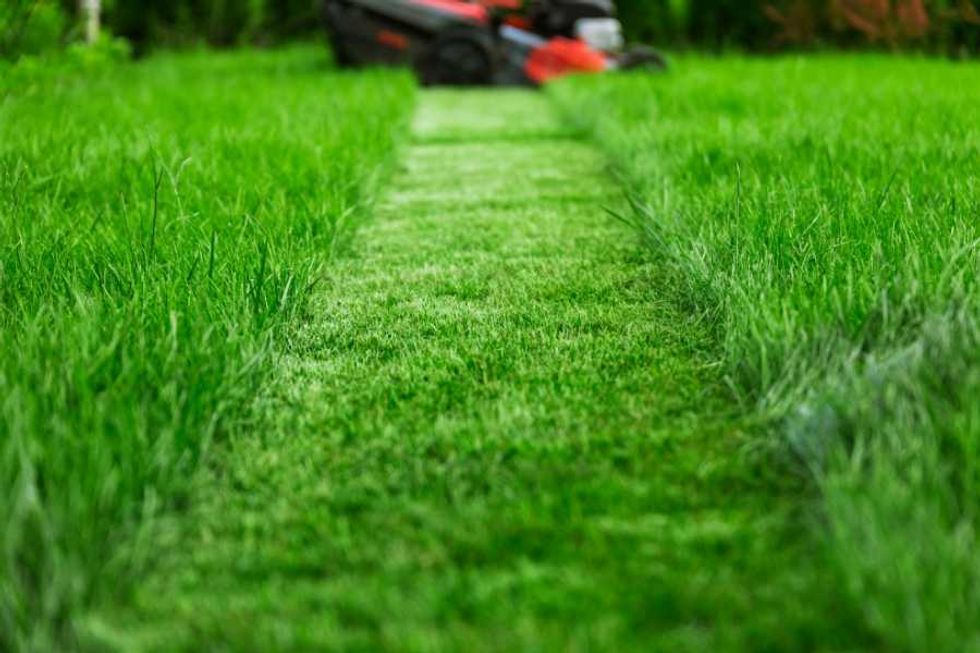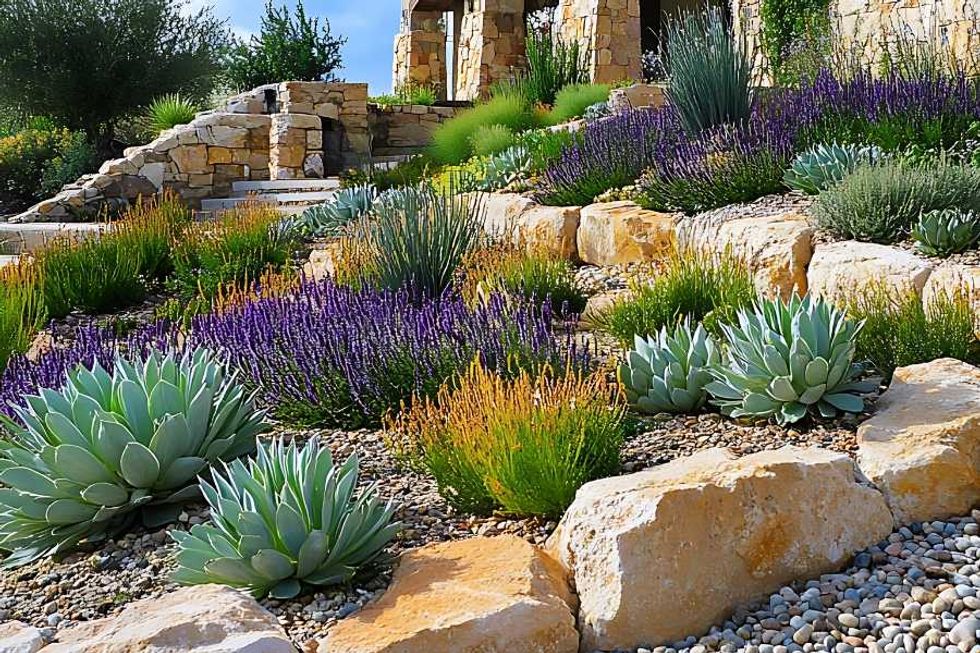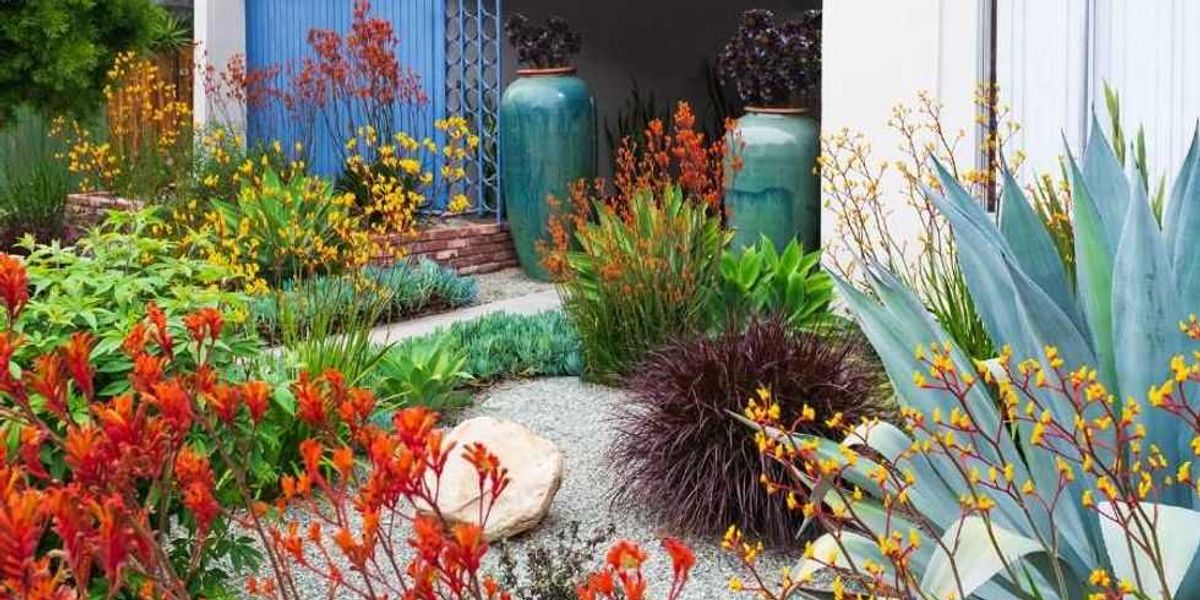Have you ever spent time in a backyard that felt like a natural oasis? An outdoor space that combines the wild beauty of nature with the aesthetic touch of human design? What if this space was not only beautiful, but also easy to maintain and environmentally friendly?
In Southern California, a mother-daughter design team is leading the way, teaching the public and their customers how to transform ordinary outdoor spaces into extraordinary plant sanctuaries. Their backyard project is an example of how, after a century of rampant urbanization—deforestation, invasive species, paving over paradises, and building a parking lot—we are finally returning to our roots.
In a viral TikTok video, Donna and Caitlin Whelan show how they created a “lush habitat garden” from an ordinary backyard. It has won the hearts of green-fingered viewers and offers a glimpse into the process of eco-friendly landscaping.
 A backyard transformation @whelanddesignhouse/TikTok
A backyard transformation @whelanddesignhouse/TikTok
Environmentally friendly choices
Donna and Caitlin run Whelan Design House, a boutique interior design firm specializing in high-end projects. Using their combined talents and impeccable taste, this mother-daughter team creates beautiful living spaces with a people-centered approach. Their commitment to a healthy environment is reflected in their design philosophy. Their website states: “Our world is full of synthetic materials, but we believe there are other options too. We guide our customers towards sustainable and environmentally friendly choices and away from chemical-laden fabrics and unhealthy materials.”
That brings us to her viral backyard makeover. This was more than just a design project: it is a masterclass in the power of family bonds and environmental innovation. The 18-part video begins with a simple, unremarkable courtyard. “This is what it looked like when we started,” they write. “The grass offered nothing to the locals [ecosystem]and it required far too much water to maintain.”
An answer to the problem of the “perfect lawn”.
America has a “perfect lawn” problem. Dreams of white picket fences and manicured lawns have turned the land into a “green monoculture carpet,” and our human-dominated landscape is no longer equipped to support functioning ecosystems. Like everything else in life, our front gardens do not exist in a vacuum. Everything from the trees to the flowers to the grass to the soil works in harmony to create a thriving home for insects, birds and other wildlife. However, when native species are replaced by non-native ones, these exotic plants disrupt the flow of life, wreak havoc and degrade natural habitats.
 Grass is beautiful, but not good for the environmentPhoto credit: Canva
Grass is beautiful, but not good for the environmentPhoto credit: Canva
So Donna and Caitlin tore it up. All of it. They removed the carefully cut grass and trees of unknown origin. Torn strips of concrete (“Concrete suffocates the soil, preventing the growth of microbes essential to healthy soil,” they write).
California's natural beauty
Once the country returned to ground zero, Caitlin and Donna went to work replacing the non-native species with ones suitable for the environment. “Native plants are adapted to the seasons, harsh weather and water availability of the area in which they evolved,” describes Defenders of Wildlife, a leading US-based conservation organization. “In addition, they are usually adapted to surviving local pests and therefore do not require chemical pesticides.”
So the dynamic duo started again with careful planning and selecting the right plants. They chose drought-tolerant flora that was either native to the area or regionally appropriate, such as acacia, whose delicate yellow flowers and fern-like leaves added a wonderful touch of splendor to the landscape. Additionally, it is known for its hardiness and minimal water requirements – a particularly important ingredient in Southern California, where droughts are unfortunately common. Orange apricot mallow, another star of her garden, adds another splash of color and sparkle and attracts butterflies to the room. “The flowers smell like honey,” the Whelans write.
 A native plant garden can be colorful even in desert areas. Photo credit: Canva
A native plant garden can be colorful even in desert areas. Photo credit: Canva
Art meets nature
Beyond the lush wildlife, the mother-daughter team also used their impressive art experiences to create the garden of their dreams. They installed a beautiful wooden bench under the shade of a Palo Verde tree. Small tables that look like sculptures stand in the courtyard. Rustic Saltillo tiles in beautiful terracotta were used to create a mosaic patio floor. Suddenly everything clicked. The resulting space is nothing short of impressive: truly at one with nature.
There was a flood of comments, with viewers praising Donna and Caitlin for their work. “You have created your own piece of paradise while taking into account the wildlife and native plant species. I am in awe,” one person wrote. “Thank you for planting native plants in California, this is so helpful. So many people buy houses here and plant non-native plants,” another user replied. Her viral TikTok even motivated some to rethink their own backyards. “My house is also a small, older Spanish-style house with a large backyard,” writes another. “This just inspired me to take action. Even my patio is just like yours, it's falling down now lol.”
 Another backyard transformation @whelanddesignhouse/TikTok
Another backyard transformation @whelanddesignhouse/TikTok
Change is always possible
There are countless ways to incorporate native vegetation into your life, whether you have a sprawling property or a simple, small plot on your doorstep. For those looking to follow in the Whelans' footsteps, here's what you need to know about starting your own oasis of native plants:
- Take stock. Before planning your beautiful new garden, examine your surroundings and evaluate what makes this particular area special and unique. How much sun does the garden usually get? Is it snowing here? What is the height? Is soil drainage poor?
- Research, research, research. This is a great excuse to take a trip and explore the surrounding area! Find a local park or botanical garden near you. Really get to know your local ecosystem – each region has its own personality and specific native plants designed to thrive there.
- The fun part: shopping. Find a nursery that specializes in native plants. And be curious! Ask questions like “Where does this plant come from?” “Do I have to fertilize it?” “Which soil and soil pH is best?” Planting a garden of native plants means becoming a steward of the land, and the more information you know, the better.
- Don't stress yourself out. Caitlin and Donna are professionals. You don't have to transform your entire garden overnight. Start small and start with just one part of the garden. This will take some time. In fact, the Whelans state, “Patience is incredibly important [the garden] reached new depths with time and only time.”
By selecting and working with native plants with The Whelans remind us that environmental stewardship is always possible – and that it can even start in your own backyard, rather than fighting against nature. With careful planning, the right plants, and an eye for design, anyone can take a step toward a natural, thriving ecosystem.
This article originally appeared in June.
